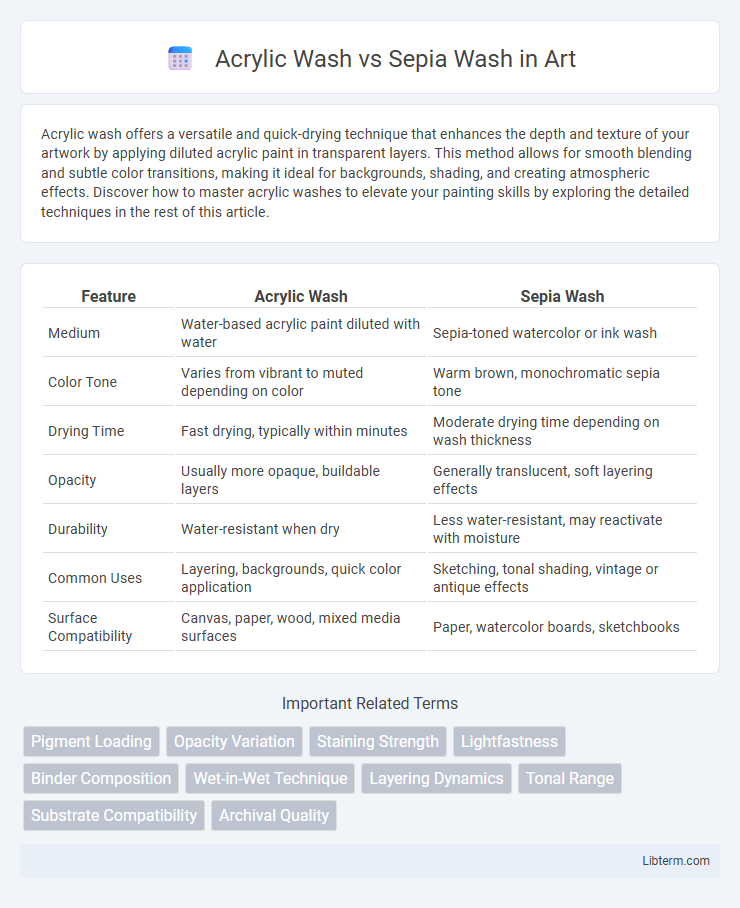Acrylic wash offers a versatile and quick-drying technique that enhances the depth and texture of your artwork by applying diluted acrylic paint in transparent layers. This method allows for smooth blending and subtle color transitions, making it ideal for backgrounds, shading, and creating atmospheric effects. Discover how to master acrylic washes to elevate your painting skills by exploring the detailed techniques in the rest of this article.
Table of Comparison
| Feature | Acrylic Wash | Sepia Wash |
|---|---|---|
| Medium | Water-based acrylic paint diluted with water | Sepia-toned watercolor or ink wash |
| Color Tone | Varies from vibrant to muted depending on color | Warm brown, monochromatic sepia tone |
| Drying Time | Fast drying, typically within minutes | Moderate drying time depending on wash thickness |
| Opacity | Usually more opaque, buildable layers | Generally translucent, soft layering effects |
| Durability | Water-resistant when dry | Less water-resistant, may reactivate with moisture |
| Common Uses | Layering, backgrounds, quick color application | Sketching, tonal shading, vintage or antique effects |
| Surface Compatibility | Canvas, paper, wood, mixed media surfaces | Paper, watercolor boards, sketchbooks |
Introduction to Acrylic Wash and Sepia Wash
Acrylic wash is a versatile painting technique using diluted acrylic paint to create translucent layers, enhancing depth and texture in artwork. Sepia wash involves applying a sepia-toned solution, traditionally derived from brown ink, to produce warm, antique effects and subtle shading. Both washes are essential for artists seeking varied tonal contrasts and atmospheric qualities in their compositions.
Understanding Acrylic Wash: Properties and Uses
Acrylic wash is a diluted acrylic paint primarily used to create translucent layers and subtle color variations in artworks, offering fast drying times and water resistance once dry. It allows artists to build depth and texture on various surfaces, including canvas, paper, and wood, making it versatile for washes, glazes, and backgrounds. Compared to sepia wash, which traditionally uses brown tones for antique effects, acrylic wash provides a broader color palette and greater durability without yellowing or cracking over time.
Exploring Sepia Wash: Characteristics and History
Sepia wash, derived from the ink of the cuttlefish, exhibits rich brown tones that create warm, antique effects in artwork, contrasting the more vibrant and versatile acrylic wash. Historically, sepia ink was favored by artists during the Renaissance for its permanence and subtle gradations, often used in sketches and detailed drawings. This wash technique enhances textures and depth with its translucent layers, making it ideal for capturing atmospheric mood in classical and contemporary art.
Advantages of Using Acrylic Wash
Acrylic wash offers superior durability and faster drying times compared to traditional sepia wash, making it ideal for artists seeking efficient workflow and long-lasting results. Its water-based formula allows easy dilution and layering without compromising pigment vibrancy, enhancing color control and versatility across various surfaces. Unlike sepia wash, acrylic wash resists fading and cracking over time, ensuring artwork maintains its original appearance with minimal preservation efforts.
Unique Benefits of Sepia Wash
Sepia wash offers a warm, vintage tone that enriches artwork with a natural, earthy feel, enhancing depth and character in illustrations and paintings. Its unique ability to create subtle gradients and aged effects makes it ideal for achieving a timeless, classical aesthetic not typically achievable with acrylic wash. Artists favor sepia wash for its smooth blending properties and distinctive color warmth, which adds nostalgic charm and visual interest to both fine art and design projects.
Key Differences Between Acrylic Wash and Sepia Wash
Acrylic wash consists of water-based acrylic paint diluted to create a translucent effect, offering vibrant and quick-drying properties ideal for layering and modern artwork. Sepia wash uses sepia-toned pigments derived from natural or synthetic sources, providing warm brown hues that evoke vintage or antique aesthetics. Key differences include their pigment composition, drying time--acrylic dries faster--and color temperature, with acrylic washes available in various colors and sepia wash primarily delivering earthy brown tones.
Best Techniques for Applying Acrylic Wash
Applying acrylic wash effectively requires thinning acrylic paint with water or acrylic medium to achieve a transparent layer that enhances texture without obscuring details. Using a soft brush and building up multiple thin layers allows better control over tone and depth compared to the monochromatic sepia wash, which offers warm, vintage hues ideal for shading and aged effects. Mastering glazing techniques and lifting excess paint with a damp cloth ensures smooth gradients and refined highlights when working with acrylic washes.
Creative Applications of Sepia Wash in Art
Sepia wash offers artists a versatile medium for creating vintage aesthetics and enhancing depth in monochromatic artworks through its warm, brownish tones reminiscent of antique photography. This medium excels in adding texture and atmospheric mood to sketches, landscapes, and portraiture, enabling artists to evoke nostalgia and timelessness. Compared to acrylic wash, which provides brighter, more opaque colors, sepia wash encourages subtle tonal variations and soft transitions, making it ideal for sepia-toned fine art, ink drawings, and mixed media compositions.
Choosing the Right Wash for Your Artistic Style
Acrylic wash offers vibrant, fast-drying colors ideal for bold, modern art techniques, while sepia wash provides warm, earthy tones suited for vintage and classical aesthetics. Artists seeking high opacity and quick layering often prefer acrylic washes, whereas those aiming for subtle shading and antique effects gravitate toward sepia washes. Understanding your artistic style and desired mood helps determine the most effective wash to enhance your visual storytelling.
Conclusion: Acrylic Wash vs Sepia Wash – Which Should You Choose?
Acrylic wash offers vibrant, fast-drying properties ideal for bold, versatile artwork, while sepia wash provides a warm, vintage tone perfect for classic, subdued effects. Choosing between acrylic and sepia wash depends on your desired color intensity and project style, with acrylic suited for modern, colorful pieces and sepia excelling in traditional, monochromatic art. Evaluate your artistic goals and medium compatibility to determine the best wash for your technique.
Acrylic Wash Infographic

 libterm.com
libterm.com